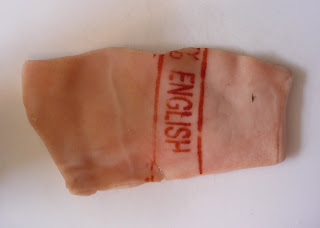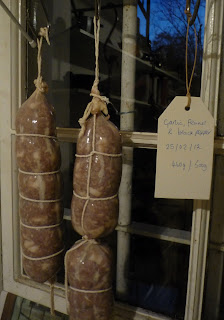
The Salami Cupboard...
by Charlotte
The idea of having a little house in the garden where the salami live seemed like a good idea.
Several things pushed me to embark on the salami project. Firstly, I went to see Jacob Kennedy (head chef at Bocca di Lupo, an Italian restaurant in Soho) talk about his cookbook. I left the evening with a copy of the book and page 80 (Finocchiona - Tuscan fennel salame) cemented in my mind. Fennel always reminds me of Italy as this is where I discovered the joys of cooking with the fennel seed and first ate the thick bulb raw with an olive oil dressing.
After these initial thoughts about salami I chatted to a friend from the Forest of Dean about the culling of the wild boar population there, due to increasing high numbers since their reintroduction. We discussed the idea of getting our hands on some boar meat to experiment with...
Finally, I read a piece by a journalist who made his own salami and hung them outdoors (in the UK) to cure. This made everything much more feasible as the Tuscan recipe is very specific and requires temperatures and humidity levels that I could not keep constant at home. So, after an email exchange with Jacob from Bocca I was confident that I could make the salami at home and hang them outside.

Pork shoulder and back fat from Kent - trial run before working with boar meat.
! worked with a kilo of meat and fat in total: 800g meat to 200g fat.
(The high fat content in salami helps to repel water and stop the meat being attacked by bacteria).
The meat is flavoured with fennel seeds, garlic and black pepper.
 The meat, fat, spices, salami culture and curing salts (28g per kilo of meat) are mixed really well - you knead the meat on the work surface for ten minutes. It is not dissimilar to working a piece of dough and is great for the arms.
The meat, fat, spices, salami culture and curing salts (28g per kilo of meat) are mixed really well - you knead the meat on the work surface for ten minutes. It is not dissimilar to working a piece of dough and is great for the arms.
The meat goes in the fridge for a couple of hours. I prep the casing - a cows intestine which is very long and has a slightly unpleasant odour. A jam funnel was the perfect size and this helped me to stuff the casings by hand.

I tied the salami with twine as they are pretty large. Make a loop in the twine at one end.
 Weigh and date the salami and hang indoors for a couple of days to kick start start the process.
Weigh and date the salami and hang indoors for a couple of days to kick start start the process.
Then transfer outdoors. The meat will gradually darken and you should expect the salami to decrease in weight by around 30%. If mould appears you can remove it with a weak vinegar water solution.
Expect to see an increase in local cats and foxes who stop by for a sniff.
One month to go until the salami party...
In that time I may experiment more as I have over twenty meters of intestine in my fridge.



